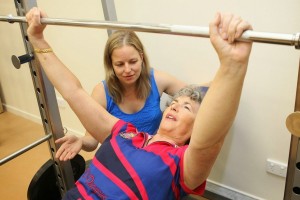
Have you heard of super slow training?
This pertains to weight training done very slowly, as in a 10-second release of the weight, after taking 4 or 5 seconds to lift it.
Super slow training is controversial; some fitness experts stand by the super slow training way, while others insist it’s inferior to traditional weight lifting. Super slow training has some benefits, however.
I’m a fitness trainer and have never had clients do super slow training, because it is NOT better than traditional weight lifting or strength training.
But I will admit that super slow training has a few virtues that you should know about.
Pros of Super Slow Training
Ideal for people with injuries. An injury may prevent you from doing your weight lifting with the usual amount of weight, but you don’t want to avoid the exercise routine altogether, either.
Using lighter weights won’t challenge you as much, unless…you employ super slow training.
For instance, suppose you have an injury that makes it painful to bench press.
Super slow training will enable you to work the muscles with a much lighter barbell, sparing your injured area of more harm, yet challenging your muscles nevertheless.
Take 4 or 5 seconds pushing up the barbell, and then take 10 seconds lowering it.
“One one-thousand, two one-thousand,” and so on. And don’t rush the mental sounding out of “one one-thousand…” either. Truly make these 4/5- and 10-counts.
Good for seniors just staring weight lifting. Super slow training may be less intimidating to old people who’ve never done strength training.

The slow movement is inviting and requires use of light weights. Also, there is less risk of injury with super slow training.
Less risk of injury. This lower risk applies to any age group, of course, so if particular strength training routines feel tweaky, you might want to replace some traditional sets with super slow training to give your muscles and joints a little break.
Cons of Super Slow Training
Again, I am a hardcore proponent of traditional weight lifting, and even though I wanted to inform you that super slow training indeed has a few good points, it is NOT the be-all, end-all for building strength, muscular endurance, speed, power, fat burning or any other benefit that is associated with strength training.
Super slow training does not mimic real-life movement, because it’s done in slow motion. In real life, you hoist, pick up, carry and push things in a quick motion.
Imagine a super slow movement with the bent-over dumbbell row.
Now imagine pulling the starter handle of a lawn mower or picking up a heavy sack with one hand if you’re other hand is occupied. These latter are fast motions.
Real life is not slow motion. Think of pushing a heavy suitcase up top the compartment in an airplane: This is a quick motion.
Super slow training skimps on recruitment of fast twitch muscle fiber.
Fast twitch muscle fiber gets targeted by traditional weight lifting a lot more than by super slow.
The more you work fast twitch muscle fiber, the more physically fit and agile you become. As well as stronger and more buff or sculpted in appearance.

Freepik.com, halayalex.
Super slow training doesn’t translate to sports performance. I can offhand think of only one sport that is done in slow motion: rock-wall climbing (and even then, I encourage traditional strength training — with light weights — for rock climbers).
Even golf is done in fast motion, when the golfer makes a big swing. Super slow training will do very little to promote better sports performance.
Super slow training can be boring. The super slow nature can drive some people batty.
Super slow training will not sculpt like traditional weight training will, nor will it build muscle mass or muscle strength like traditional strength training or body building will.
 Lorra Garrick is a former personal trainer certified by the American Council on Exercise. At Bally Total Fitness she trained clients of all ages for fat loss, muscle building, fitness and improved health.
Lorra Garrick is a former personal trainer certified by the American Council on Exercise. At Bally Total Fitness she trained clients of all ages for fat loss, muscle building, fitness and improved health.
.











